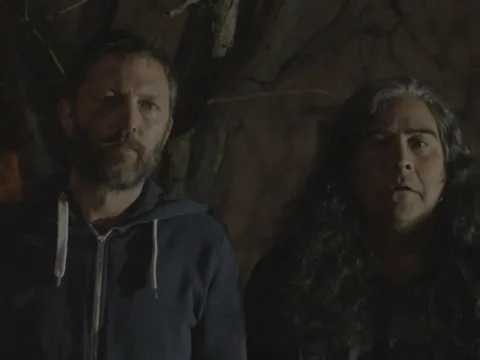As classical musicians become more interested in styles of playing outside of what is traditionally taught in conservatories, we are beginning to see more recordings that interact with multiple genres in dynamic and original ways. On Corpus Vice, cellist and composer Eden Rayz doesn’t just oscillate between the two musical extremes of death metal and contemporary classical music – she blends them into a wholly original sound world that broadly comments on climate change and oligarchy. Rayz also performs in the bands Angel Grinder and Scaphism, and with Corpus Vice, she has created a fully realized sonic experience from beginning to end – the release date (May 16, 2022) coinciding with the recent total lunar eclipse and blood moon.
Opening the album, the first minute of Saint Anthony’s Fire is something of a microcosm that represents much of what Rayz explores throughout Corpus Vice: music that simultaneously references the broader contemporary classical world within the context of a dark metal album. This is music that has each foot rooted in different musical worlds at all times, which creates a fascinating stylistic push and pull between improvisation, drum beats, complicated rhythms, and noise.
Saint Anthony’s Fire begins with a wash of percussion – three drumsets plus brake drum all recorded in studio by Austin Birdy – which leads into Rayz’s amplified and distorted cello. Corpus Vice contains music that can and should be performed live, but also deliberately uses the recording studio as an instrument; three drumsets playing in phase, two flutes double tracked, and so on create a sense that this is a musical world the listener has stumbled into, not just a representation of something happening in a concert hall.
Also using recording as a creative medium is Threnody No. 1, which was improvised within a cathedral utilizing the space’s natural echo. This piece would be difficult to replicate in a different space, as the physicality of the room is integral to the work’s dramatic arc. A threnody is traditionally a memorial for the dead, and the dense and jagged sound world created by the low range of Rayz’s detuned and amplified cello along with the lyrics “Did you rip it from the ground?” seems to be a memorial for a dying planet.
The centerpiece of the album is the seven-movement eponymous work. Scored for two flutes (double tracked on this recording by Antonina Styczeń), clarinet (Shannon Leigh), bassoon (Grant Bingham), percussion (Austin Birdy), electric guitar and bass (Will Ponturo), and amplified cello (Rayz), Corpus Vice utilizes techniques ranging from slow drones and crescendos to unrestricted noise to minimalist soundscapes.

The first movement, “Awareness,” begins with a long build that ultimately devolves into unstructured noise and ambient guitar chords, setting up a texture that continues for the majority of the multi-movement work. In “Vice,” the tension established by guitar and flute drones broken up by unpredictable loud entrances from the percussion never totally pays off in the huge climax that we might expect.
In “Resist,” the bassoon and marimba expand on the initial guitar idea introduced in “Awareness,” although the musical space grows denser and more complex. Vibraphone replaces marimba in “Ascension,” again building on the tension that’s been established for the previous three movements. Rayz sings in an otherworldly black metal growl while hits from the guitar and percussion make the whole movement feel like it could erupt into chaos at any moment.
In “Acceptance,” the drums establish a consistent beat while the guitar overlays feedback and noise. In between some of the louder moments are extremely evocative soundscapes of whispering and string scratching. The last movement, “Devotion,” finally delivers on the promise of an ultimate climax of noise, mirroring the beginning of the work but not necessarily coming full circle. If Corpus Vice is a comment on climate change, then surely a possible reading of the ending is that climate change is an issue that builds upon itself, always getting bigger, louder, and more terrifying.

In the wake of Corpus Vice, the album closes with Threnody No. 2, described by Rayz as a “quiet meditation on the destruction of oceans.” Performed in one take by flutist and vocalist Antonina Styczeń, the piece is the only purely acoustic performance across the record, but finds just as much opportunity to explore new sounds. Melodic figures are augmented by simultaneous humming and singing by Styczeń, which gives way to scooped and bent notes. The final moment of the piece is a quick inward breath, placing a sharp punctuation on a piece that primarily explores longer tones.
Corpus Vice is possibly a tough sell for those unfamiliar with growling and screaming vocal styles, but shouldn’t deter anyone from giving the album a listen. There are so many beautifully composed moments throughout that explore timbre, melody, and rhythm in ways that really shine a light on the incredible possibilities of cross-genre experimentation. Corpus Vice makes a strong case for why composers should be studying as diverse a selection of music as possible, and hopefully we’ll get more albums that stretch musical boundaries in the same exciting ways.
I CARE IF YOU LISTEN is an editorially-independent program of the American Composers Forum, funded with generous donor and institutional support. Opinions expressed are solely those of the author and may not represent the views of ICIYL or ACF.
A gift to ACF helps support the work of ICIYL. For more on ACF, visit the “At ACF” section or composersforum.org.
























